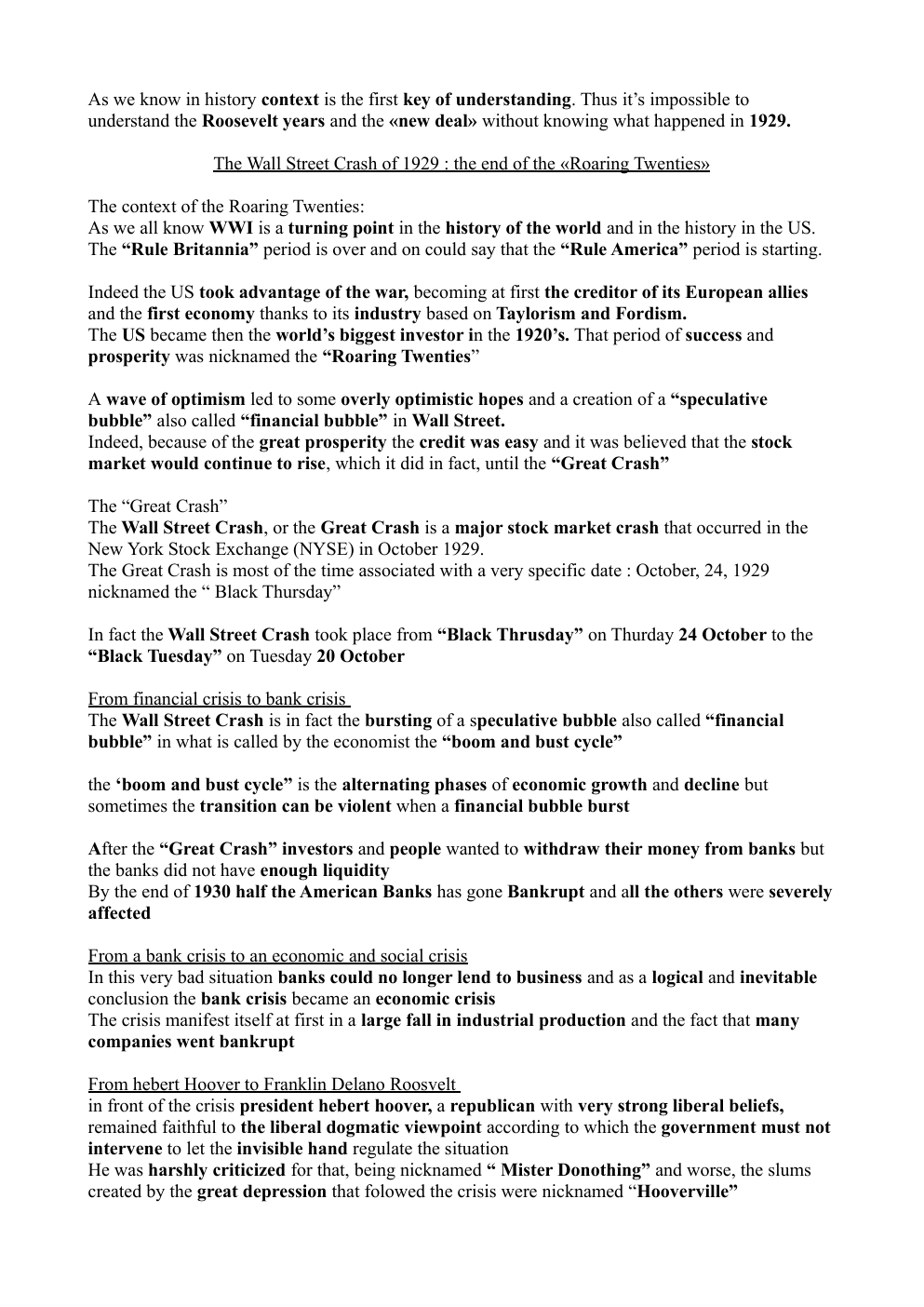The Wall Street Crash of 1929 : the end of the «Roaring Twenties»
Publié le 08/10/2023
Extrait du document
«
As we know in history context is the first key of understanding.
Thus it’s impossible to
understand the Roosevelt years and the «new deal» without knowing what happened in 1929.
The Wall Street Crash of 1929 : the end of the «Roaring Twenties»
The context of the Roaring Twenties:
As we all know WWI is a turning point in the history of the world and in the history in the US.
The “Rule Britannia” period is over and on could say that the “Rule America” period is starting.
Indeed the US took advantage of the war, becoming at first the creditor of its European allies
and the first economy thanks to its industry based on Taylorism and Fordism.
The US became then the world’s biggest investor in the 1920’s.
That period of success and prosperity was nicknamed the “Roaring Twenties” A wave of optimism led to some overly optimistic hopes and a creation of a “speculative bubble” also called “financial bubble” in Wall Street. Indeed, because of the great prosperity the credit was easy and it was believed that the stock market would continue to rise, which it did in fact, until the “Great Crash” The “Great Crash” The Wall Street Crash, or the Great Crash is a major stock market crash that occurred in the New York Stock Exchange (NYSE) in October 1929. The Great Crash is most of the time associated with a very specific date : October, 24, 1929 nicknamed the “ Black Thursday” In fact the Wall Street Crash took place from “Black Thrusday” on Thurday 24 October to the “Black Tuesday” on Tuesday 20 October From financial crisis to bank crisis The Wall Street Crash is in fact the bursting of a speculative bubble also called “financial bubble” in what is called by the economist the “boom and bust cycle” the ‘boom and bust cycle” is the alternating phases of economic growth and decline but sometimes the transition can be violent when a financial bubble burst After the “Great Crash” investors and people wanted to withdraw their money from banks but the banks did not have enough liquidity By the end of 1930 half the American Banks has gone Bankrupt and all the others were severely affected From a bank crisis to an economic and social crisis In this very bad situation banks could no longer lend to business and as a logical and inevitable conclusion the bank crisis became an economic crisis The crisis manifest itself at first in a large fall in industrial production and the fact that many companies went bankrupt From hebert Hoover to Franklin Delano Roosvelt in front of the crisis president hebert hoover, a republican with very strong liberal beliefs, remained faithful to the liberal dogmatic viewpoint according to which the government must not intervene to let the invisible hand regulate the situation He was harshly criticized for that, being nicknamed “ Mister Donothing” and worse, the slums created by the great depression that folowed the crisis were nicknamed “Hooverville” Not surprisingly in the Presidential election of 1932 the Republican Herbert Hoover was beaten by the democrat Franklin Delano Roosevelt who had a very interventionist program. It was a very large victory for Roosevelt in the popular vote with 57% but a landslide victory in the Electoral College with 89% The new president could then launch his ambitious policy with a strong legitimacy The New Deal against the Great Depression The first members of the bari trust xer coming from columr xer joinedd leter by the professirs it was prpbably samuel rosenmen To prevent a reapeted stock market crash the securittes act of 1933 in which the government imposed some regulations to the stock market was ^ssed in may in order to fight the huge unemployment roosvelt created some administrations such as the national recovery administration (nra), the publiic work administration (pwa) or the tennessee.... »
↓↓↓ APERÇU DU DOCUMENT ↓↓↓
Liens utiles
- The Buddha of suburbia
- the stolen generation
- Is there one side of the coin in the myth of the frontier?
- The impact of social media on our societies through the changes in lifestyles, diversity and human rights.
- Crise de 1929 et ses conséquences


